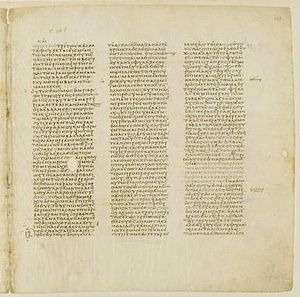Biblical Interpretation
A number of different types of biblical interpretation were employed by the sectarians as well as by other Jewish groups of the period. The Dead Sea Scrolls contain some of the earliest translations of the Bible into Greek and Aramaic. The scrolls also contain early attempts to explain the peshat (plain sense) of the Biblical passages. Manuscripts retelling the Bible reflect the exegetical methods of the author. Interpretation of the biblical law is found in the sectarian legal literature. The pesher scrolls are interpretations of prophetic texts as referring to present events and the history of the sect itself.
The Earliest Translations
The earliest known translation of the Bible was the Greek translation called the Septuagint, translated from the third century BCE to the first century BCE. This translation had a wider canon than the Hebrew Bible and contained some apocryphal works. After it was discarded by the Jews, the Septuagint was preserved by the church.
The Septuagint was not simply a literal translation of the Bible as we know it for a number of reasons. Firstly, the translators introduced Hellenistic terms and concepts to the text. While this made the text more accessible to the Greek reader, it also changed its meaning. Secondly, the translation was occasionally done from a Hebrew text which was not the prevalent version of the text. In some places, the Septuagint reveals knowledge of interpretations which would later find their way into rabbinic literature.
Cave 7, which yielded only Greek manuscripts, and Cave 4, both contained fragments of the Septuagint, totaling six fragments. These manuscripts are closer to the later textual tradition of the Septuagint. They do contain some readings which demonstrate that this text was revised from an earlier “Old Greek” version of the Septuagint.
The earliest translations composed in Palestine were the Targumim (Aramaic translations), starting in the Hasmonean period. The earliest Targumim in existence, found at Qumran, are the Leviticus and Job Targumim. These are literal translations which do not deviate much from the text. Later Targumim, which were used in synagogues to translate the Torah readings, were freer with their additions and interpretations. Nonetheless, some examples of exegesis can be found in the Targumim from Qumran.
The Genesis Commentary, a retelling of the flood story, contains examples of plain sense commentary. This type of commentary is more complex than Targum, which simply translates the words. Instead, it deals with the larger issues in the biblical text.
The apocryphal literature—or retellings of the Bible—contains interpretations which are similar to the rabbinic Aggadic literature. At first glance, they appear to be simply legends, but they are in fact attempts to fill gaps in the biblical narrative. This form of narrative retelling is found in presectarian documents at Qumran, proving that this approach was already developing before the Maccabean Revolt.
Harmonizing interpretation was popular in and outside of Qumran. This type of interpretation assumes that all of the biblical texts are part of one body of literature and that one text can be used to interpret the other. The Temple Scroll uses this method often in order to remove ambiguity from the biblical texts. This technique is similar to that of analogy used later in rabbinic exegesis.
Even when no ambiguity exists, Jewish law is based on interpretation of one verse in light of another. This method of interpretation, called Halakhic Midrash, was also employed at Qumran. Rabbinic Midrash interpreted only verses from the Torah, whereas the Qumran Midrash uses verses from the Prophets and the Writings as well. It is likely that the Rabbis avoided interpretation of the Prophets and the Writings because of the use the Christians made of these passages in order to justify their theology. The Qumran texts, which are pre-Christian, were not affected by this concern.
These methods of interpretation were not unique to the sectarians, but one method—the pesher method—was developed by the sect and served to interpret the events of the time as the fulfillment of God’s prophecy to Israel.
Secondary Sources
- Biblical Interpretation, Lawrence H. Schiffman, Reclaiming the Dead Sea Scrolls, Jewish Publication Society, Philadelphia 1994.
- Halakhic Midrash, Lawrence H. Schiffman, Reclaiming the Dead Sea Scrolls, Jewish Publication Society, Philadelphia 1994.
- Harmonizing Interpretation, Lawrence H. Schiffman, Reclaiming the Dead Sea Scrolls, Jewish Publication Society, Philadelphia 1994.
- Plain Sense Commentary, Lawrence H. Schiffman, Reclaiming the Dead Sea Scrolls, Jewish Publication Society, Philadelphia 1994.
- Retelling the Bible, Lawrence H. Schiffman, Reclaiming the Dead Sea Scrolls, Jewish Publication Society, Philadelphia 1994.
What do you want to know?
Ask our AI widget and get answers from this website
